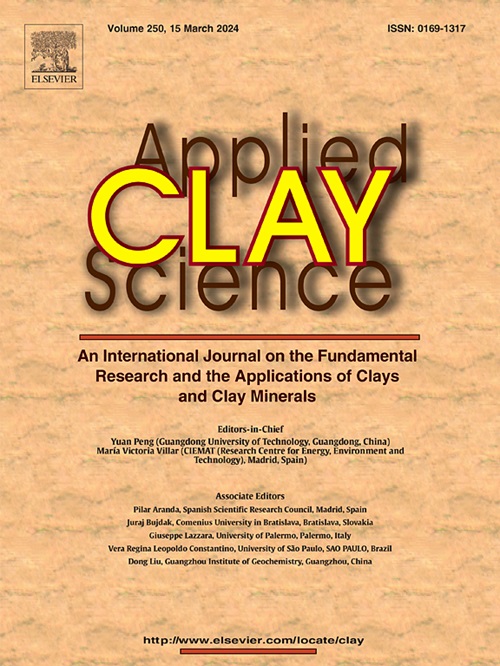3D fabric reconstruction and image processing for clays - New method using SEM-FIB technique and AI
IF 5.8
2区 地球科学
Q2 CHEMISTRY, PHYSICAL
引用次数: 0
Abstract
This paper proposes a new technique for the 3D identification of clay particle orientations using images obtained from FIB-SEM observations. The method is based on a three-dimensional reconstruction that combines the Focused Ion Beam abrasion technique and Scanning Electron Microscopy, applied to kaolinitic clay selected for this study. The clay was first subjected to one-dimensional compression up to a given stress level, after which microstructural observations were performed using a post-mortem approach.
A novel methodology using appropriate image processing was established for this purpose, allowing for a precise treatment of the obtained FIB-SEM images. The proposed methodology first involved removing “curtain effects” and “charging artefact”, which are specific types of noise commonly associated with FIB-SEM images. Two methods were employed to address this issue and were compared to evaluate their effectiveness: the first method was based on Fourier Transformation and Total Variational Reconstruction, while the second used a stochastic approach formulated as a convex optimization problem. Subsequently, a machine learning technique was integrated to enhance the segmentation process of the images. The final stage of the methodology involved creating a 3D model by reconstructing the clay particles in their spatial configuration. This paper aims to demonstrate how the proposed 3D observation method enables the quantification of the structural organization of clay particles in space in relation to mechanical loading.
粘土三维织物重建与图像处理——基于SEM-FIB技术和人工智能的新方法
本文提出了一种利用FIB-SEM观测图像三维识别粘土颗粒取向的新技术。该方法基于三维重建,结合聚焦离子束磨损技术和扫描电子显微镜,应用于本研究选择的高岭石粘土。粘土首先受到一维压缩到给定的应力水平,之后使用尸检方法进行微观结构观察。为此目的建立了一种使用适当图像处理的新方法,允许对获得的FIB-SEM图像进行精确处理。提出的方法首先涉及去除“幕效应”和“充电伪影”,这是通常与FIB-SEM图像相关的特定类型的噪声。采用了两种方法来解决这个问题,并对其有效性进行了比较:第一种方法是基于傅立叶变换和全变分重构,而第二种方法使用了一种随机方法,该方法被表述为凸优化问题。随后,结合机器学习技术增强图像的分割过程。该方法的最后阶段涉及通过重建粘土颗粒的空间配置来创建3D模型。本文旨在证明所提出的三维观测方法如何能够量化与机械载荷有关的粘土颗粒在空间中的结构组织。
本文章由计算机程序翻译,如有差异,请以英文原文为准。
求助全文
约1分钟内获得全文
求助全文
来源期刊

Applied Clay Science
地学-矿物学
CiteScore
10.30
自引率
10.70%
发文量
289
审稿时长
39 days
期刊介绍:
Applied Clay Science aims to be an international journal attracting high quality scientific papers on clays and clay minerals, including research papers, reviews, and technical notes. The journal covers typical subjects of Fundamental and Applied Clay Science such as:
• Synthesis and purification
• Structural, crystallographic and mineralogical properties of clays and clay minerals
• Thermal properties of clays and clay minerals
• Physico-chemical properties including i) surface and interface properties; ii) thermodynamic properties; iii) mechanical properties
• Interaction with water, with polar and apolar molecules
• Colloidal properties and rheology
• Adsorption, Intercalation, Ionic exchange
• Genesis and deposits of clay minerals
• Geology and geochemistry of clays
• Modification of clays and clay minerals properties by thermal and physical treatments
• Modification by chemical treatments with organic and inorganic molecules(organoclays, pillared clays)
• Modification by biological microorganisms. etc...
 求助内容:
求助内容: 应助结果提醒方式:
应助结果提醒方式:


